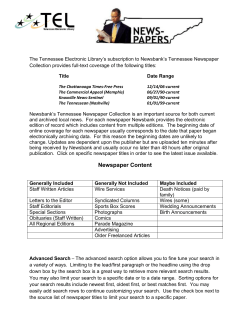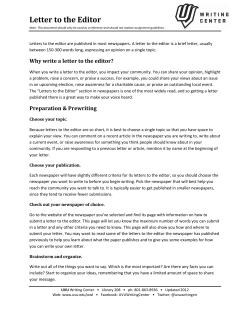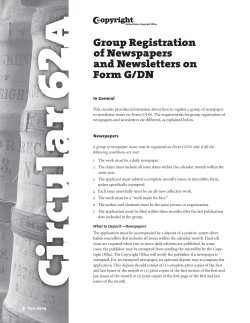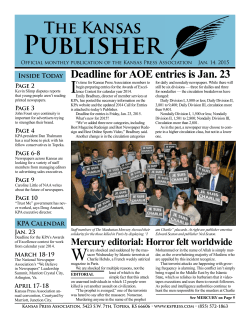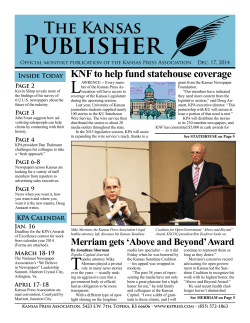
THE FURRY NEWS: HOW
THE FURRY NEWS: HOW TO MAKE A NEWSPAPER If possible, take a field trip to a newspaper office. Visit the area where the newspaper is printed in addition to the areas where writing and layout are done. THEME: Cut pictures and single cartoons from newspapers and leave off the captions. Have students write new captions for these pieces. Author: Loreen Leedy Publisher: Holiday House There’s more to newspapers than the news. PROGRAM SUMMARY: Creating a newspaper involves many tasks as Big Bear, Rabbit, and other animals learn when they publish “The Furry News.” They share tips for publishing a newspaper and introduce newspaper terms. Viewers find out about creating a school newspaper—from brainstorming story ideas to layout design, printing and distribution. LeVar talks about the different sections of a newspaper, the variety of newspapers that are published, and he interviews the creator of a nationally distributed comic strip, who talks about his characters and creating the strip. Hang different pages of a newspaper on a wall or bulletin board and have students make word labels for the different areas that reflect newspaper terminology, e.g., lead, headline, editorial, byline, feature, cutline, etc. Cut apart frames of a comic strip and have students sequence them in the correct order. (Be sure that there is enough action from frame to frame so that a sequence is evident.) Have the students conduct a survey of favorite comic strips. Survey the class, the grade level, or even the whole school. Graph the results and display the graph for all to see. TOPICS FOR DISCUSSION: Cut 12 x 18-inch sheets of drawing paper in half horizontally. Mark the pieces into four frames and give a strip of paper to each student. Have the students create a cartoon strip. Encourage them to look at books illustrated with cartoon art for ideas about drawing characters and using bright colors. Look at examples of comic strips to see how word balloons are placed. Before viewing, discuss the purposes of newspapers. Ask students what can be found in a newspaper. After watching the program, see if their ideas have changed and determine what discoveries they made. Create a current events bulletin board composed of newspaper items contributed by students. Allow opportunities for sharing and discussing items before they are placed on the board. From the story, discuss why Big Bear thought the animals should have a newspaper of their own. Why is it important to have one’s local area represented in or by a newspaper? Discuss the “5 W’s” (who, what, when, where, why) that a newspaper reporter asks before writing a story. Read the first few paragraphs of some newspaper stories that have topics of interest to the students and discuss the 5 W’s in the articles. (The articles in regular newspapers might be too difficult for the students. The level of school newspapers or those from Weekly Reader or Scholastic might be more appropriate to discuss.) Create situations in which students have the opportunity to write a newspaper story using the 5 W’s. Write a word or phrase on cards for each of the 5W categories and place the cards in appropriately labeled boxes. Have students draw one card from each box and write a news story using those five details. Discuss different ways people have of getting news. Are some ways of getting news more readily available than others? Why do we need to know the news of the day? CURRICULUM EXTENSION ACTIVITIES: Bring in samples of different types of newspapers—daily, weekly, neighborhood, school—large and small. Allow students the opportunity to browse the papers. Discuss the different sections they find. What is in a newspaper besides news articles? What is in a newspaper besides print? Invite someone who works for a newspaper, such as a reporter or editor, into the classroom to discuss her/his work. Before the visit, have the class develop a set of appropriate interview questions to ask the guest. Use The Furry News as an example for creating a class newspaper. READING RAINBOW TEACHER’S GUIDE Program #92 — The Furry News: How to Make a Newspaper 2008 GPN/WNED, Buffalo NY. All Rights Reserved. Organize a recycling project for all the newspapers in the school building. Solicit parent volunteers to help take the papers to a recycling center. RELATED THEMES: communications careers Proudly sponsored by: RELATED READING RAINBOW PROGRAMS: Program #119 — Owen Program #17 — Simon’s Book Program #53 — Knots On A Counting Rope ABOUT THE AUTHOR: Loreen Leedy has been writing and illustrating children’s picture books since 1984 and has published over 20 books. Messages in the Mailbox (a Reading Rainbow review book), Bunny Play, and The Great Trash Bash are all companion books to The Furry News. Leedy is also the author/illustrator of Reading Rainbow review book, The Edible Pyramid. BOOKS REVIEWED BY CHILDREN: GREAT NEWSPAPER CRAFTS by F. Virginia Walter, illus. by Teddy Cameron Long (Sterling Publishing) NEWSPAPERS by David Petersen (Children’s Press) WHAT IT’S LIKE TO BE A...NEWSPAPER REPORTER by Janet Craig, illus. by Richard Max Kolding (Troll Associates) SUPPLEMENTARY BOOKLIST: THE NEWSPAPERS by Leonard Everett Fisher (Holiday House) DEADLINE! FROM NEWS TO NEWSPAPER by Gail Gibbons (T. Y. Crowell) PAPERBOY by Mary Kay Kroeger and Louise Borden, illus. by Ted Lewin (Clarion) A TRUE PARTNERSHIP by Patricia Lakin, illus by Doug Cushman (Raintree Steck-Vaughn) HOT OFF THE PRESS! A DAY AT THE DAILY NEWS by Margaret Miller (Crown) THE PAPERBOY by Dav Pilkey (Orchard Books) HOW NEWSPAPERS ARE MADE by Sarah Walters (Facts on File) CARTOONS AND CARTOONING by Harvey Weiss (Houghton Mifflin) READING RAINBOW TEACHER’S GUIDE Program #92 — The Furry News: How to Make a Newspaper 2008 GPN/WNED, Buffalo NY. All Rights Reserved. Proudly sponsored by:
© Copyright 2025




